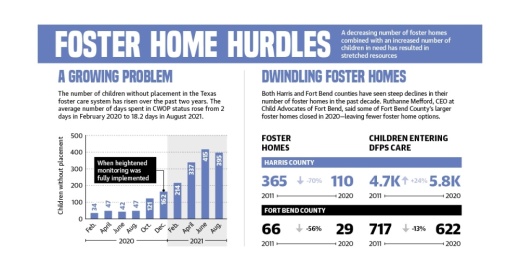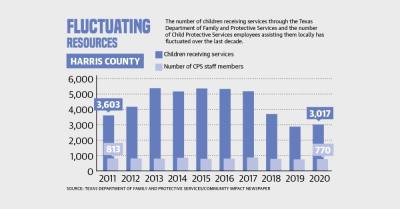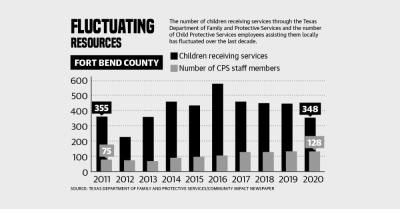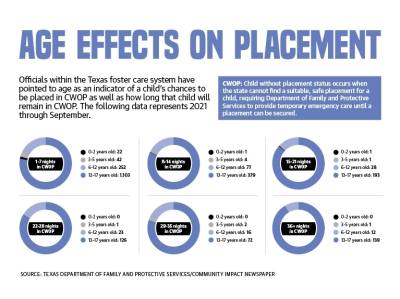According to DFPS officials, individuals in the state’s foster care system receive a “child without placement” designation, or CWOP, when the state cannot find a suitable and safe placement for that child, requiring the DFPS to provide temporary emergency care until a placement can be secured.
Over the last two years, the state has increasingly relied on unlicensed placements—often motels or office buildings—overseen by caseworkers. In October 2019, 32 children were in such placements statewide, according to DFPS data. By August 2021, that number had risen to 395 children.
Many of these children requiring placements have suffered physical abuse, sexual abuse and neglect, according to officials with Child Advocates of Fort Bend—a nonprofit agency that assists child victims of abuse and neglect through two nationally-affiliated programs: Court Appointed Special Advocates and the Children’s Advocacy Center.
According to Child Advocates of Fort Bend, CASA supports children in the foster care system by recruiting, training and deploying community advocates to support children in courts. The CAC acts as a safe, child-friendly place for Child Protective Services or law enforcement to bring alleged victims. It offers services to help victims and their non-offending family members move forward after abuse.
Through these programs, Child Advocates of Fort Bend has served more than 18,000 children in the county since its creation 30 years ago.
Ruthanne Mefford, CEO at Child Advocates of Fort Bend, said the frequency of child abuse incidences increased during the pandemic. Simultaneously, she said some placements were not able to take children for various reasons, such as fear of potential exposure to COVID-19 and the closures of multiple foster homes throughout the county.
“It’s not just our county,” she said. “Throughout the state, there have been a large number of children without placement.”
DFPS officials have attributed the increase to challenges associated with the ongoing pandemic, caseworker turnover and new regulations.
“We’ve worked really, really hard to find the kids’ placements,” Mefford said. “It’s a continuing issue. It’s not solved yet.”
Extenuating circumstances
In an August CWOP report, DFPS officials said the number of children in CWOP had risen, in part, because of heightened monitoring regulations mandated after U.S. District Judge Janis Graham Jack ruled in 2015 that foster children in Texas “almost uniformly leave state custody more damaged than when they entered.”
The lawsuit alleged youth in the foster care system were often bounced between homes, had too little contact with overworked caseworkers, and were not sufficiently protected from physical and sexual abuse.
Resulting system reforms included heightened monitoring, which is implemented when certain foster care system entities have had a high rate of standard and contract violations.
Entities placed under heightened monitoring are given a plan by court monitors to address deficiencies and are subject to weekly visits to ensure compliance. Operations that fail to address issues within a year can have their licenses revoked, placements suspended, contracts terminated or face fines, according to DFPS.
Since January 2020, 21 general residential operations—facilities with 13 or more children—have been shut down or had their licenses revoked statewide, resulting in the loss of about 1,200 beds, according to a September court monitor update. Moreover, several entities facing heightened monitoring voluntarily closed during that time frame, resulting in the additional loss of 375 beds and 157 foster homes statewide.
Rebecca Mercer, regional director of statewide adoption agency Lonestar Social Services, said heightened monitoring has also led to some foster parents removing themselves from the system altogether.
“[Heightened monitoring has] forced us to enforce stricter rules on our foster parents, and they have definitely felt the heat from that, which, in turn, turns foster parents away because it’s too stressful,” she said.
Still, Mercer said she understood why the restrictions were imposed.
“We’re trying to weed out those parents who may not have the best interests for the child because there are some out there,” Mercer said.
She also said the pandemic has made finding placements more difficult.
“We’ve had a lot of foster parents that will come to us and say, ‘Until COVID is over, we’re not interested in taking placements anymore because it’s just too much,’” she said.
Searching for solutions
The DFPS has identified a need for 669 additional beds throughout the state to meet growing demands on the welfare system. Additionally, the department said it is lacking an adequate number of CPS caseworkers with 236 vacancies statewide.
With these issues, the state of Texas passed several pieces of legislation during the pandemic to address some of these needs.
State Senate Bill 1896, passed in May, revised and added regulations for the DFPS, including forbidding the department from housing a child in an office overnight, expanding eligibility for therapeutic foster care and transitioning into electronic case management.
Additionally, the DFPS requested an additional $83.1 million as part of Senate Bill 1 to hire 312 caseworkers, which the Legislature fully funded, according to the September CWOP report. House Bill 5, which passed in September, allotted an additional $90 million to the DFPS, which will be used to retain providers and increase capacity to serve foster youth.
“The importance of this funding cannot be overstated,” said Melissa Lanford, the media specialist for DFPS Region 6, which includes the Greater Houston area. “It is the difference between a real placement for these older children and continuing to live in a CPS office or hotel.”
In the September CWOP report, DFPS Commissioner Jaime Masters said many providers have cited heightened monitoring as a reason for declining a placement, although she noted that did not indicate the department’s disapproval of the mandate.
“DFPS is not ‘blaming’ the CWOP crisis on the court’s heightened monitoring orders,” Masters said. “While the monitors have noted DFPS’ ‘collaborative’ efforts of listening to concerns of its stakeholders, it is an undisputed fact that DFPS cannot do this alone.”
She said caseworker turnover resulting from overworked employees has contributed to the growing number of CWOP. Between February and July, the DFPS hired 319 caseworkers, but 309 caseworkers left their roles during that time. According to 2021 exit surveys, 86% cited work-related stress as a reason for terminating their employment, up from 40% in 2020.
Despite the presence of additional staff members, Masters said the average number of hours each employee spent supervising CWOP per month increased from 22.5 hours in December 2020 to 35.7 hours in July.
In Harris County, the number of children receiving services through the DFPS rose by 141 from 2019 to 2020, while the number of staff members fell by 14 during that same period, according to DFPS data. Conversely, the number of Fort Bend County children receiving services through the DFPS decreased by 92 from 2019 to 2020, while the number of staff members rose by nine during that same period, according to the same data.
Mefford attributed the drop in 2020 due to less contact happening between children and mandated reporters during the pandemic.
“Initially, reports of child abuse went down because children weren’t going to school,” she said. “Teachers, our largest reporters, weren’t seeing children in person. Initially reports went down, but when things started to open up, the numbers went up.”
In October, Texas Gov. Greg Abbott approved the creation of a new expert panel to analyze the rising number of foster care children in CWOP. The panel’s recommendations were due to the governor’s office Dec. 15.
Harris County commissioners at a Dec. 15 meeting unanimously approved the construction of a roughly $35 million Houston Alumni and Youth Center campus that will include a 41,000-square-foot, 50-unit residential facility for youth transitioning out of the state’s foster care system.
The approximately 3.3-acre campus, which will be located at 3131 Gulf Freeway near downtown Houston, will also include a 17,000-square-foot commercial facility that will house the HAY—Houston Alumni & Youth—Center, a program operated through the Harris County Resources for Children and Adults Department that provides resources and services for youth and young adults exiting the state foster care system.
County officials said construction of the new campus is expected to begin in the first quarter of 2022 and is slated to wrap up by the third quarter of 2023.
Officials noted the project is primarily funded through Community Development Block Grant Disaster Recovery grants received by the county and the city of Houston.
Advocation and adoption
Despite the growing number of children in the foster care system, 5,270 children were adopted in Texas in 2020—including 592 in Harris County and 46 in Fort Bend County.
According to Mefford, when a child is removed from their home and brought into the foster care system, they are assigned a CASA. She said while a child is in a foster home, they advocate for their needs.
“[We do] everything that we can do to help that child thrive while they’re in [foster] care,” Mefford said.
When CASA advocates attend the child’s court visits, they make recommendations based on the child’s situation, Mefford said. Depending on the circumstances, the child may return to their family—if their family is capable and able to take them. On Nov. 19, National Adoption Day, 13 children in Fort Bend County had their adoptions formalized by county judges.
“But in some cases, that’s not able to happen,” Mefford said. “In those situations, there’s an opportunity, in some cases, for the children to be adopted—and that’s a wonderful outcome.”










